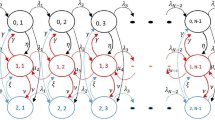Abstract
In public transport punctuality has prominent influence on the customers’ satisfaction. Our task is to support a management decision to optimally invest passengers’ nominal travel time to secure the nominal schedule against delay. For aperiodic scheduling we clarify the notion and use of a fixed amount of time supplements, so-called buffers, both theoretically and by realistic examples. The general tool to solve such optimization problems is a sampling approach. We show how this approach is mathematically justified. As its applicability to large networks is limited, we show an efficient alternative for the case of series-parallel graphs. For periodic timetabling we propose two heuristic approaches to ensure a certain level of delay resistance at the least expense of slightly increased nominal passengers travel time, and analyze in detail their advantages and drawbacks.
Similar content being viewed by others
References
Berger A, Lorenz U, Hoffmann R, Stiller S (2008) TOPSU-RDM: a simulation platform for railway delay management. In: Proceedings of SimuTools, 2008
Bertsimas D, Sim M (2003) Robust discrete optimization and network flows. Math Program Ser B 98:49–71
Gatto M, Jacob R, Peeters LWP, Schöbel A (2005) The computational complexity of delay management. In: Kratsch D (ed) Graph-theoretic concepts in computer science (WG 2005). LNCS, vol 3787. Springer, Berlin, pp 227–238
Hagstrom J, Jane N (1990) Computing the probability distribution of project duration in a PERT network. Networks 20:231–244
Kroon LG, Dekker R, Vromans M (2007) Cyclic railway timetabling: a stochastic optimization approach. In: Geraets F et al. (eds) Algorithmic methods for railway optimization. LNCS, vol 4359. Springer, Berlin, pp 41–66
Liebchen C, Möhring RH (2007) The modeling power of the periodic event scheduling problem: railway timetables—and beyond. In: Geraets F et al. (eds) Algorithmic methods for railway optimization. LNCS, vol 4359. Springer, Berlin, pp 41–66
Liebchen C, Proksch M, Wagner F (2008) Performance of algorithms for periodic timetable optimization. In: Hickman M et al. (eds) Computer-aided systems in public transport. LNEMS, vol 600. Springer, New York, pp 151–180
Ludwig A, Möhring R, Stork F (2001) A computational study on bounding the makespan distribution in stochastic project networks. Ann Oper Res 102:49–64
Shapiro A, Nemirovski A (2005) On complexity of stochastic programming problems. In: Jeyakumar V, Rubinov AM (eds) Continuous optimization: current trends and applications. Springer, New York, pp 111–144
UIC (2000) Timetable recovery margins to guarantee timekeeping—recovery margins. Leaflet 451-1, Union Internationale des chémins de fer, Paris, France
Van Slyke R (1963) Monte Carlo methods and the PERT problem. Oper Res 11:839–860
Author information
Authors and Affiliations
Corresponding author
Additional information
This work has been supported by the DFG Research Center Matheon in Berlin, and by the EU Specific Targeted Research Project ARRIVAL.
Rights and permissions
About this article
Cite this article
Liebchen, C., Stiller, S. Delay resistant timetabling. Public Transp 1, 55–72 (2009). https://doi.org/10.1007/s12469-008-0004-3
Published:
Issue Date:
DOI: https://doi.org/10.1007/s12469-008-0004-3




